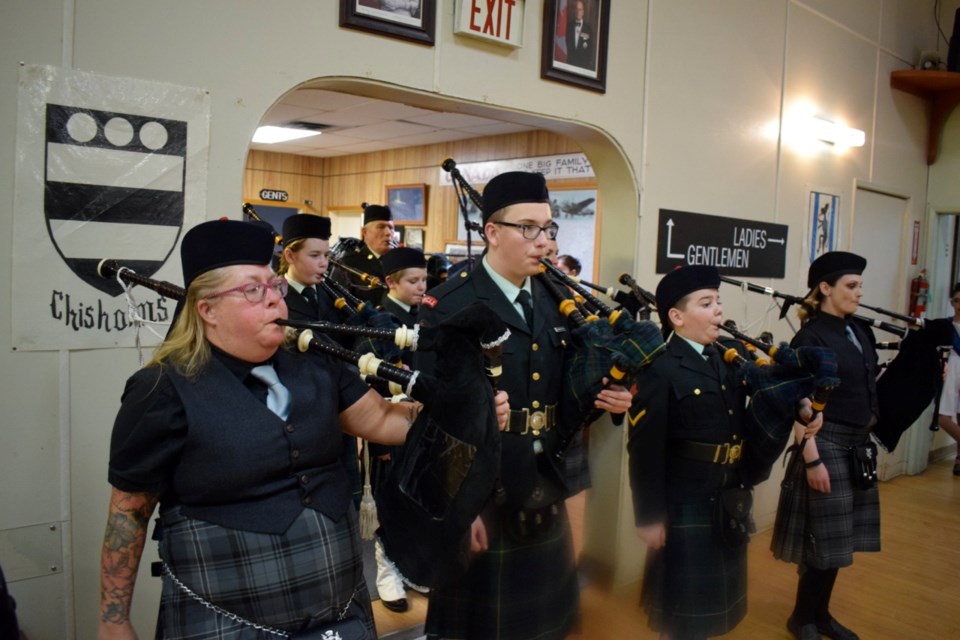Estevan residents had their opportunity to celebrate Scottish culture and the contributions of Scotland’s greatest poet during the annual Robbie Burns Night Saturday at the Royal Canadian Legion’s Estevan branch.
Hundreds of people attended the festivities, which were hosted by the No. 2901 PPCLI Estevan Army Cadet Corps. The evening featured plenty of music, dancing, food and other elements important to Scottish culture.
Members of the Estevan (Elks) PPCLI Pipe Band provided entertainment, and they were joined by the Drewitz School of Dance for several numbers. The pipe band performed such selections as Scotland the Brave, Hills of Alva, Brown-haired Maiden and other Scottish favourites. There was also a drummer’s call.
The Drewitz dancers joined in for such routines as the blue bonnets, lilt, a jig and a Highland fling dance.
Lance Corporal Leo Mitchell delivered the address to the haggis prior to supper.
The event was also an opportunity to celebrate the life of Burns, who rose to fame in Scotland in the second half of the 18th century.
Master Corporal Brayden Lachambre-Renkas was tasked with reading the immortal memories of Robert Burns, which is a staple of the Estevan Burns night.

Burns was born at a family farm in Scotland on Jan. 25, 1759.
“He was a poet and lyricist who rose up to become the national poet of Scotland, whose works are still celebrated around the world today,” Lachambre-Renkas said.
Burns had a simple start to life, working the family farm with his father and six siblings. Most of his education came from his father, with the exception of a year spent at a parish school.
At age 15, he made his first foray into poetry during harvest when he wrote Once I lov’d a Bonnie Lass. But it wasn’t until he was running out of funds that he sent his work to a printer. His work, Poems, Chiefly in the Scottish dialect, was published in 1986.
“It sold for three schillings and contained much of his best writing, including The Twa Dogs, Address to the Deil, Halloween, the Cotter’s Saturday Day, to a Mouse, Epitaph for James Smith and To a Mountain Daisy.”
The success of his work was immediate, and soon he was known across the country.
“Burns’ style is marked by his spontaneity, directness and serenity, and he ranges from the tender intensity of some of his lyrics, to the humour of Tam O’ Shanter to the satire of Holy Willy’s Prayer.”
Not only was he skilled in the Scottish language, but he mastered the Scottish-English dialect. According to Lachambre-Renkas, themes of Burns’ work included radicalism, Scottish patriotism, class inequalities, gender roles, Scottish cultural identity, poverty, sexuality and socializing.
He became a celebrity in Scotland because of his writings. A second editions of his poems proved to be a hit as well.
Burns also wrote lyrics, including 100 songs to the melodies of tunes, and put the words to Scottish folk melodies.
“He made a statement saying how he had to master the tunes, before he composed the words,” said Lachambre-Renkas.
Burns died on July 20, 1796 at the age of 37 due to heart problems. Through his 12 children, Burns has more than 900 living descendants, as of 2019.
“Burns’ legacy is honoured throughout the world,” said Lachambre-Renkas. “He has been the inspiration for many Scottish, English, Canadian and American writers. He was toasted by Abraham Lincoln, and part of his poem To a Mouse was used by John Steinbeck in Of Mice and Men.
He has received numerous honours, including statues and memorials. Streets, vehicles and even a crater on the planet Mercury are named after him. Burns Day is also the biggest holiday of the year in Scotland.



